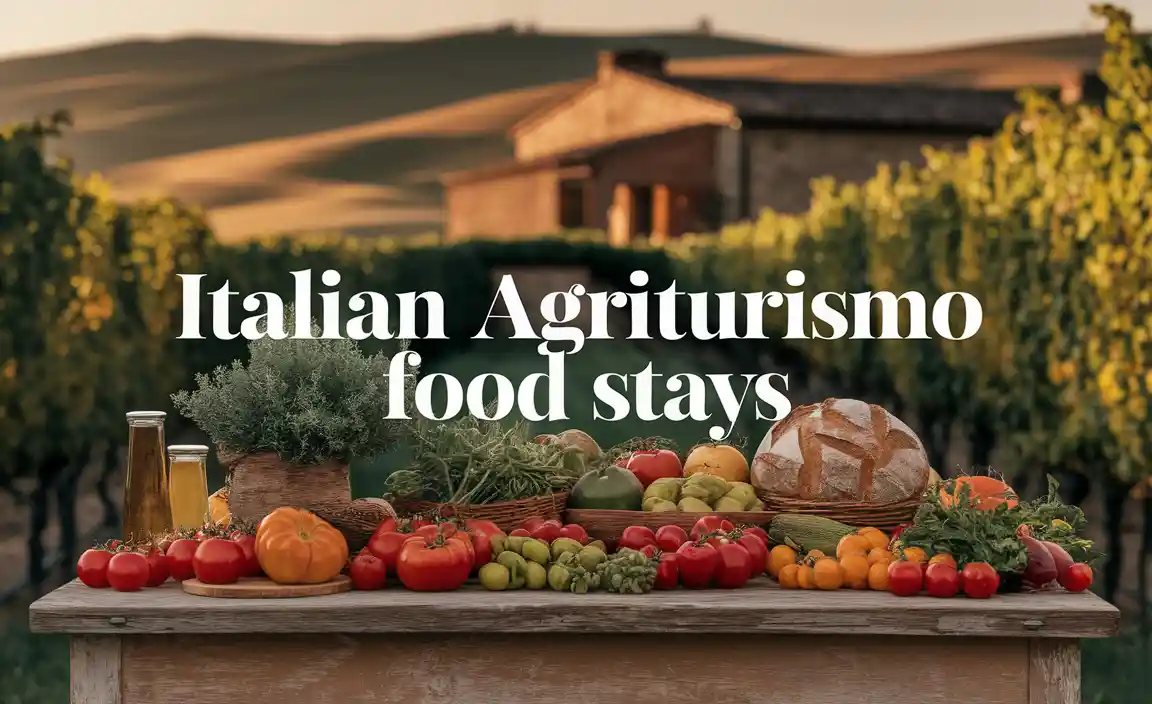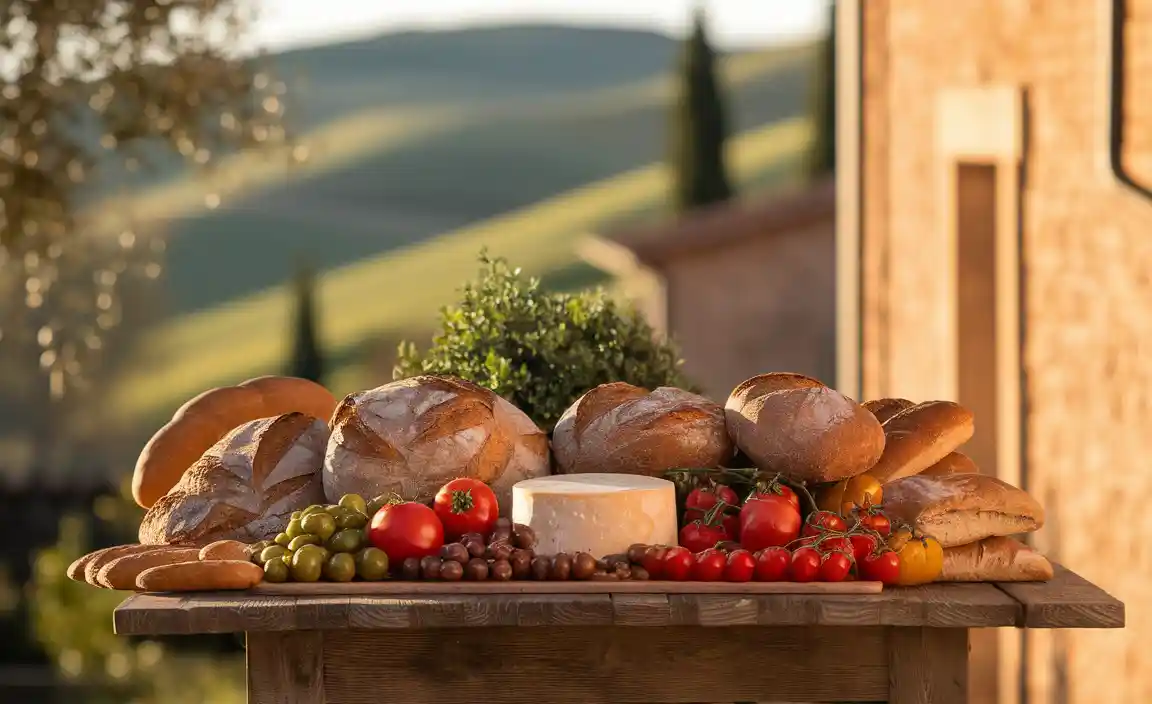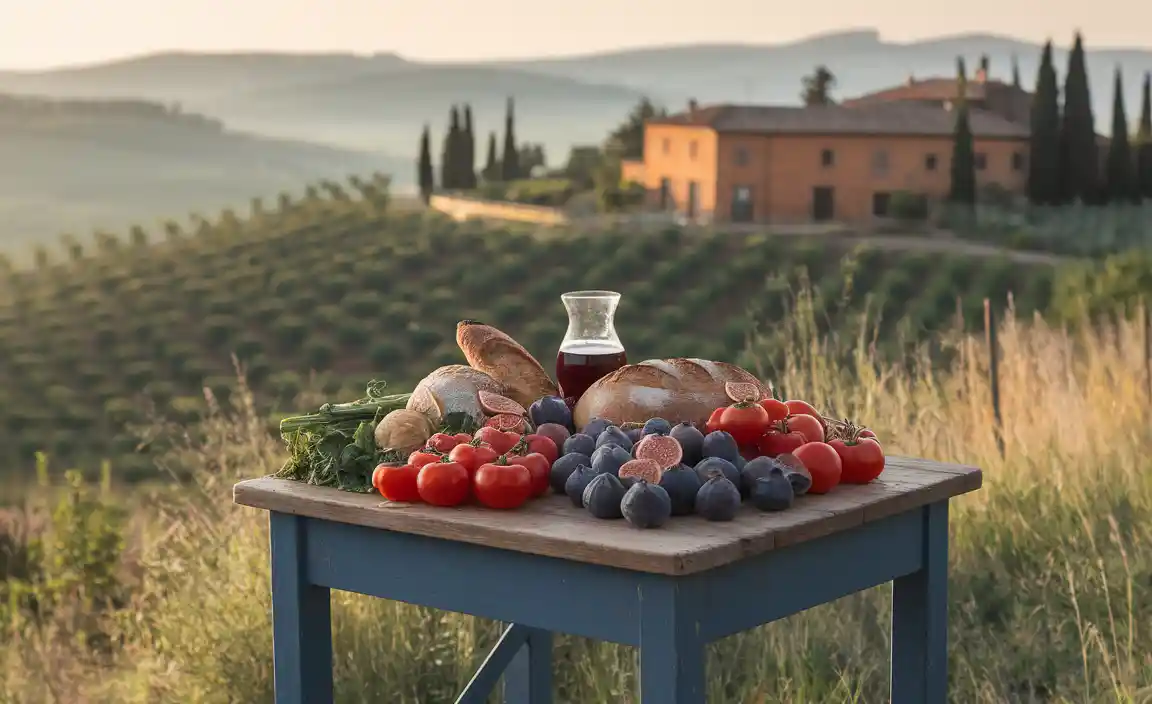Italian agriturismo food stays offer an immersive, farm-to-table experience where you eat delicious, local food, often made right on the property. It’s a fantastic way to taste authentic Italy, connect with producers, and enjoy genuine hospitality.
Dreaming of Italy? Picture sun-drenched vineyards, rolling hills, and the aroma of fresh basil filling the air. Now, imagine tasting that dream, not just seeing it! Traditional Italian `agriturismo` stays are your ticket to experiencing the heart of Italian food culture. Forget ordinary hotels; an agriturismo is a working farm that opens its doors to guests. It’s a chance to savor incredible, home-cooked meals made with ingredients grown just steps away. If you’re a food lover eager to taste the real Italy, you’re in the right place!
This guide will walk you through everything you need to know to plan an unforgettable Italian agriturismo food stay. We’ll cover what to expect, how to choose the perfect spot, and the must-have culinary experiences that await you. Get ready to discover a delicious side of Italy you might have only dreamed of!

What is an Italian Agriturismo Food Stay?
An agriturismo literally translates to “agriculture tourism.” It’s a special type of accommodation in Italy where guests stay on a working farm. These farms, often generations old, produce their own food – think olive oil, wine, cheese, fruits, and vegetables. What makes an agriturismo food stay so magical is that the food served to guests often comes directly from these farm-grown ingredients. It’s a genuine farm-to-table experience, where you get to taste the pure flavors of the Italian countryside.
These aren’t just places to sleep; they are invitations to experience a slower, more authentic way of life. You’ll likely meet the farm owners, learn about their agricultural traditions, and enjoy meals prepared with immense care and local pride. This is a far cry from a generic hotel buffet; it’s a deep dive into the culinary soul of Italy.

Why Choose an Agriturismo for a Foodie Adventure?
If your taste buds are leading your travel plans, an agriturismo is your ultimate destination. Here’s why:

- Unbeatable Freshness: Ingredients are harvested at their peak, often just hours before they land on your plate. This means vibrant flavors that store-bought produce can’t match.
- Authentic Recipes: You’ll taste traditional dishes passed down through generations, prepared with love and regional expertise. No tourist traps here!
- Meet the Producers: Get to know the people who grow your food. Many agriturismos offer tours, tastings, and cooking classes, giving you insight into Italian agricultural heritage.
- Support Local Agriculture: By staying and dining at an agriturismo, you directly support small, family-run farms and promote sustainable farming practices.
- Immersion in Culture: It’s more than just food; it’s a chance to live like a local, breathe the country air, and understand the deep connection Italians have with their land and food.
Essential Experiences to Seek Out
When planning your Italian agriturismo food stay, look for places that offer these quintessential experiences. They’re the moments that transform a good trip into an extraordinary culinary journey:
1. The Farm-to-Table Dinner
This is the cornerstone of any agriturismo food stay. Expect multi-course meals that showcase the best of what the farm and the surrounding region have to offer. A typical dinner might start with a selection of local antipasti (appetizers), followed by a primo piatto (first course, usually pasta or risotto), a secondo piatto (main course, often meat or fish), and a dolce (dessert).
The beauty lies in the simplicity and quality of the ingredients. You might savor homemade pasta with a sauce made from sun-ripened tomatoes, enjoy slow-cooked lamb raised on the farm, or indulge in a panna cotta flavored with local berries. Don’t be afraid to ask about the ingredients – the hosts love to share their story!
2. Wine Tastings and Vineyard Tours
Many Italian agriturismos are nestled in famous wine regions like Tuscany, Piedmont, or Sicily. If wine is your passion, seek out farms that produce their own wines. A guided tour of the vineyards and cellars is incredibly insightful. You’ll learn about the grape varietals, the winemaking process, and the history tied to the land.
The tasting session that follows is a highlight. You’ll sample different wines, often paired with local cheeses, cured meats, or bruschetta. It’s a fantastic way to discover new favorite Italian wines and understand the nuances of regional production. For more on Italy’s diverse wine regions, the official Italian Wine Podcast offers excellent insights.
3. Olive Oil and Balsamic Vinegar Experiences
Italy is renowned for its high-quality olive oil and balsamic vinegar. Several agriturismos specialize in their production. A visit might include a tour of olive groves and pressing facilities, explaining how they extract thatLiquid Gold. You’ll learn to distinguish between different types of olive oil based on varietal and region.
Similarly, if you’re in regions known for balsamic vinegar (like Modena or Reggio Emilia), look for producers offering guided tastings. True traditional balsamic vinegar is aged for years, sometimes decades, and has a complex, sweet-tart flavor that’s utterly unique. Tasting sessions often involve trying different ages and styles, revealing the incredible depth and artistry involved. The Consortium of Traditional Balsamic Vinegar of Modena provides fascinating details on its production.
4. Cheese-Making Demonstrations and Tastings
From the creamy mozzarella of Campania to the aged Pecorino of Sardinia, Italian cheeses are as diverse as the country itself. Some agriturismos have dairy farms and offer demonstrations of cheese-making. Witnessing the transformation of fresh milk into delicious cheese is captivating.
Following the demonstration, a cheese tasting is often on the menu. You’ll get to sample various cheeses, learning about their textures, aromas, and flavors. They are often served with local honey, jams, or crusty bread, allowing you to appreciate the full spectrum of each cheese’s character.
5. Hands-On Cooking Classes
What better way to learn the secrets of Italian cuisine than by learning from the source? Many agriturismos offer cooking classes where you can roll up your sleeves and learn to make classic Italian dishes, from fresh pasta to tiramisu. These classes are usually taught by the farm family, giving you an authentic, insider perspective.
You’ll typically prepare a meal using the farm’s produce, which you then get to enjoy together. It’s a fun, interactive way to build culinary skills and create delicious memories. These classes are a fantastic way to take a piece of Italy home with you to your own kitchen.
6. Foraging and Local Produce Discovery
Depending on the season and location, some agriturismos offer foraging excursions. Learn to identify edible wild herbs, mushrooms, or berries under the guidance of an experienced local. It’s an adventurous way to connect with the natural environment and discover ingredients that might otherwise go unnoticed.
Even without formal foraging, simply exploring the farm’s gardens and orchards is a treat. Hosts are usually delighted to show you what’s in season and how they grow it. You might even get to pick some ripe tomatoes, figs, or cherries to enjoy later!
Choosing Your Ideal Agriturismo Food Stay
With thousands of agriturismos scattered across Italy, finding the perfect one can seem daunting. Here’s a checklist to help you narrow down your options:
1. Location, Location, Location
Italy is incredibly diverse. Are you dreaming of the olive groves of Tuscany, the vineyards of Piedmont, the coastal flavors of Sicily, or the mountains of Trentino-Alto Adige? Research regions known for the types of food and wine you love most. Each region has its own agricultural specialties and culinary traditions.
2. Farm Type and Production
Are you particularly interested in wine? Olive oil? Organic vegetables? Cheese? Look for agriturismos that highlight the specific produce you’re most excited about. Many farms may specialize in one or two things, offering a deeper expertise in those areas.
3. Activities and Amenities
Beyond dining, what do you want to do? Check if they offer cooking classes, wine tastings, farm tours, hiking trails, or perhaps even activities like horseback riding. Consider the amenities: do you need a pool? Is Wi-Fi important? Are pets allowed?
4. Dining Style
Some agriturismos offer formal multi-course dinners, while others might have a more rustic, family-style approach. Some provide breakfast only, while others offer lunch and dinner. Read reviews and descriptions carefully to understand their meal philosophy and schedule. Some might even have an on-site restaurant open to the public, which can be a great sign of quality.
5. Reviews and Reputation
Online reviews are invaluable. Look for comments specifically about the food, the hospitality of the hosts, and the overall experience. Websites like Agriturismo.it, Slow Food’s ‘Osterie d’Italia’, or even general travel sites can be helpful resources.
A Sample Agriturismo Food Experience Itinerary
To give you a better idea, here’s what a delightful 3-day agriturismo food itinerary might look like:
Day 1: Arrival and Rustic Welcome
- Afternoon: Arrive at your chosen agriturismo. Settle into your room and take a moment to explore the farm surroundings.
- Late Afternoon: Enjoy a complimentary tasting of the farm’s own olive oil and local bread, perhaps with a glass of the farm’s wine.
- Evening: Savor a delicious, home-cooked welcome dinner featuring regional specialties made with the freshest ingredients.
Day 2: Culinary Immersion
- Morning: Participate in a hands-on cooking class. Learn to prepare fresh pasta and a classic Italian sauce.
- Lunch: Enjoy the fruits of your labor! Feast on the dishes you helped prepare.
- Afternoon: Take a guided tour of the farm’s vineyards or olive groves, followed by a wine or olive oil tasting session.
- Evening: A different menu for dinner, perhaps highlighting seasonal vegetables or a local meat dish.
Day 3: Local Flavors and Departure
- Morning: Enjoy a final farm breakfast featuring fresh pastries, local jams, and fruits. Perhaps a final stroll through the gardens.
- Late Morning: Visit a nearby local market to purchase some of the delicious products you’ve tasted – cheese, cured meats, honey, or handmade pasta.
- Departure: Depart with a full belly and wonderful memories, fully inspired by authentic Italian food and hospitality.
Practical Tips for Your Agriturismo Stay
To ensure your agriturismo food stay is as smooth and enjoyable as possible, keep these tips in mind:
- Book in Advance: Especially during peak season, popular agriturismos fill up quickly.
- Check Meal Times: Agriturismo meals are often served at specific times. Confirm these upon arrival and make reservations if necessary.
- Dietary Needs: If you have allergies or dietary restrictions, inform the agriturismo when booking. Many are very accommodating.
- Transportation: Agriturismos are often in rural areas. Having a car can be beneficial for exploring nearby towns and markets. Some offer pick-up services or are accessible by public transport, so check this beforehand.
- Embrace the Pace: Agriturismos offer a chance to slow down. Relax, enjoy the surroundings, and savor the food and company.
- Learn a Few Italian Phrases: While many hosts speak some English, knowing basics like “Grazie” (Thank you) and “Buon appetito” (Enjoy your meal) goes a long way.
Agriturismo Food Stays vs. Other Travel Options
How does an agriturismo compare to other ways of experiencing Italian food?
| Feature | Italian Agriturismo Food Stay | City Restaurant Dining | Standard Hotel Breakfast |
|---|---|---|---|
| Food Source | Directly from the farm; hyper-local | Varies; often relies on supply chains | Mass-produced; generic |
| Authenticity | Very high; traditional recipes, family preparation | Can be authentic, but also tourist-oriented options | Low; often standardized international fare |
| Experience | Immersive, educational, connection with producers | Focused on dining out, exploring urban food scene | Basic necessity; functionality over experience |
| Cost | Often excellent value, especially when meals are included. Can range from budget to mid-range. | Can be very expensive, especially at high-end restaurants. | Usually included in the room rate. |
| Prepared By | Farm family members, often with generations of experience. | Professional chefs; sometimes with Michelin stars. | Hotel kitchen staff; varying skill levels. |
As you can see, the agriturismo offers a unique blend of accommodation and culinary experience that is hard to replicate elsewhere. It’s a complete immersion into the food culture of a specific Italian region.
FAQs about Italian Agriturismo Food Stays
What is the typical cost of an agriturismo stay with food?
Costs vary widely based on region, luxury level, and whether meals are included. Many agriturismos offer packages that include accommodation and half-board (breakfast and dinner). You might find options ranging from €60-€80 per person per night for a comfortable, mid-range stay with meals, to €150+ for more upscale or specialized experiences. It’s often more affordable than comparable hotel stays combined with restaurant dining.
Are agriturismos good for families with children?
Absolutely! Many agriturismos are family-friendly, offering open spaces for children to play, sometimes farm animals to see, and a relaxed atmosphere. The simpler, healthier food is often a hit with kids too. Always check for specific family amenities when booking.
Can I buy the products I tasted at the agriturismo?
Yes, usually! Most agriturismos sell directly to guests. You can often purchase their excellent olive oil, wine, jams, honey, cheese, and other products. It’s a fantastic way to take a genuine taste of Italy home with you.
Do I need to speak Italian to stay at an agriturismo?
While knowing some Italian is helpful and appreciated, it’s not usually essential. Many agriturismo owners, especially in tourist areas, speak at least basic English or are happy to use translation apps. Patience and a friendly smile go a long way!
What is the difference between an agriturismo and an ‘agriturismo ristorante’?
An ‘agriturismo ristorante’ specifically highlights its restaurant component. While all agriturismos serve food to guests, an ‘agriturismo ristorante’ often puts a greater emphasis on its dining experience, being comparable to a fine restaurant in terms of menu and culinary offer, while still being rooted in farm production.
Are all agriturismos organic?
Not all agriturismos are certified organic, but many prioritize sustainable practices and use natural methods. Increasingly, farms are focusing on organic or biodynamic agriculture. It’s worth checking the farm’s philosophy and certifications if this is important to you.
How do I find agriturismos that offer specific food experiences like cooking classes or wine tastings?
Search specialized agriturismo booking websites (like Agriturismo.it, FarmStayPlanet, or European Farmhouse Inns) and use their filters to select desired activities like “cooking classes,” “wine tasting,” or “farm tours.” Reading detailed descriptions and reviews will also give you clues about their offerings.
Conclusion
An Italian agriturismo food stay is more than just a vacation; it’s a chance to reconnect with the source of your food, to embrace authentic flavors, and to experience the genuine warmth of Italian hospitality. From the meticulously prepared dinners showcasing farm-fresh ingredients to the intimate wine tastings and hands-on cooking lessons, every moment is an opportunity to deepen your appreciation for Italy’s rich culinary heritage. By choosing an agriturismo, you’re not just a tourist; you’re a guest becoming part of a long-standing tradition of land, food, and family.
So, pack your bags, bring your appetite, and get ready for an unforgettable gastronomic adventure. The rolling hills, sun-kissed fields, and delicious meals of Italy await you. Buon viaggio and perhaps more importantly, buon appetito!